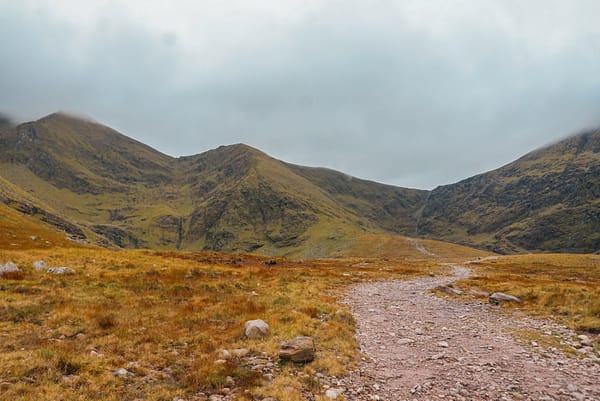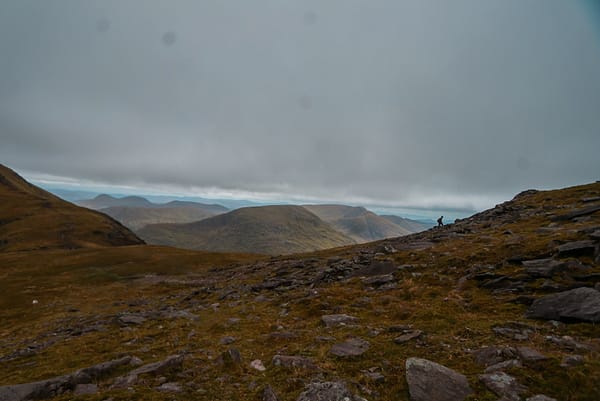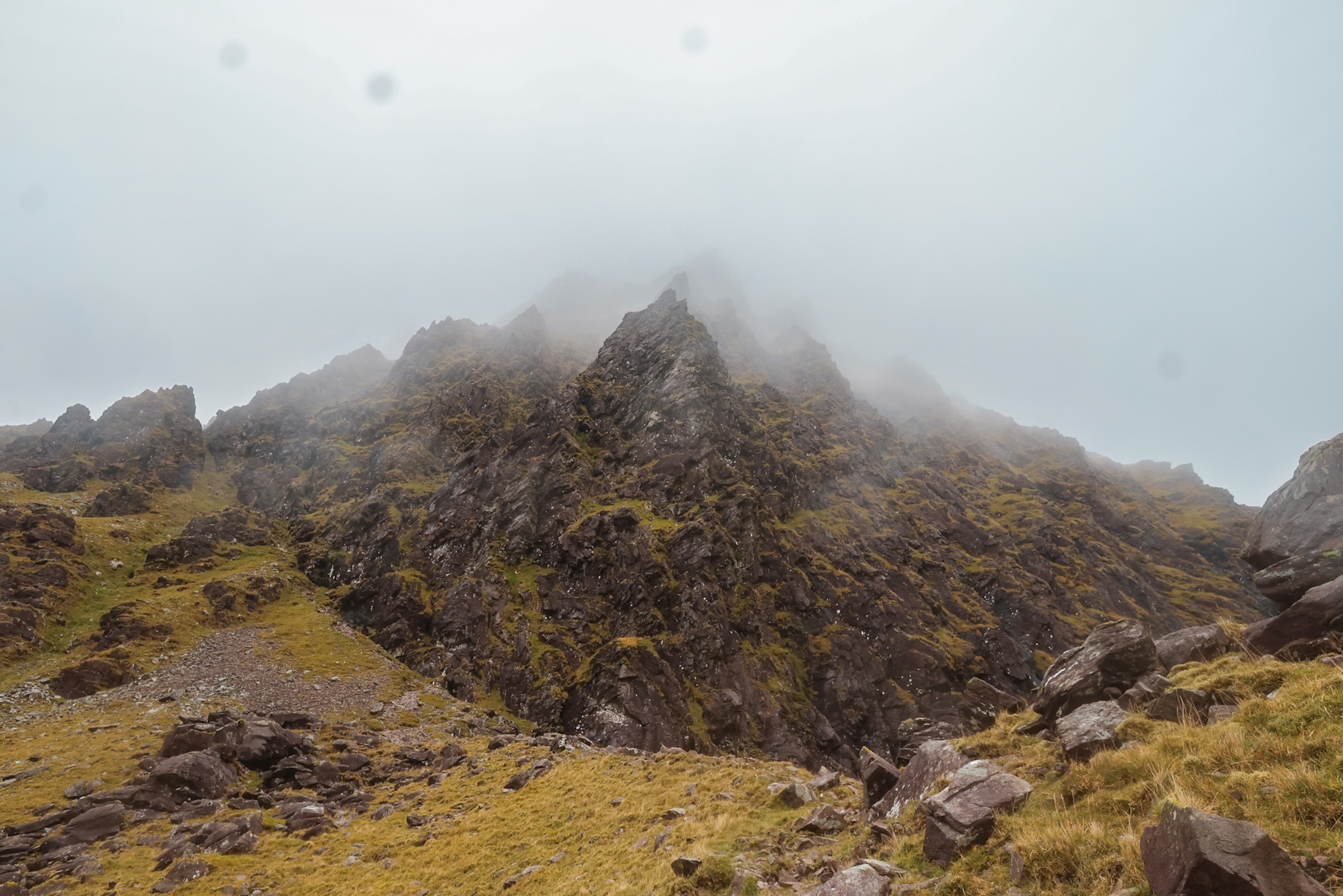Standing at 1,039m (3,045 feet), Carrauntoohil is the highest peak in Ireland and a beacon for adventurers and nature lovers alike. Nestled in the breathtaking MacGillycuddy's Reeks mountain range in County Kerry, climbing Carrauntoohil offers you some of the most spectacular panoramic views in Ireland and an incredible sense of achievement.
In this Explore by Nature guide, you'll learn all about Carrauntoohil and its history, how to organise climbing Carrauntoohil, the many routes up and down the mountain, and my own personal experience climbing Carrauntoohil in 2024.
Carrauntoohil: A Brief Overview
Carrauntoohil derives its name from the Irish "Carrantoohil", meaning "the hill of torture", but don't let this intimidate you, this is a beautiful mountain to climb set in the stunning countryside of County Kerry. The mountain is characterised by its rocky summit and the large Celtic cross erected in honour of the hundreds who have traversed its trails.

The route towards the Devil's Ladder ascent for Carrauntoohil, Ireland.
During the 18th and 19th centuries, the peak began to gain recognition as a hiking destination. It became a favoured spot among Victorian-era adventurers and naturalists who sought to explore the untamed beauty of the Irish wilderness. Notably, in 1943, the first recorded ascent of Carrauntoohil was made by the famous English artist and climber Richard Hayward. Carrauntoohil holds a prominent place in Irish culture, not just for its size but also its role in the local identity and landscape. The mountain is often celebrated in Irish literature, poetry, and music.
Why Should You Climb Carrauntoohil?
Climbing Carrauntoohil offers breathtaking views of the surrounding mountains, valleys, and lakes, including the glacial lakes of the Reeks and the Wild Atlantic Way visible in the distance. For those seeking an adrenaline rush, Carrauntoohil is an exhilarating challenge. The variety of routes, including the popular Devil's Ladder and the more technical Coomhola route, caters to different skill levels, making it an ideal mountain for both novice and experienced hikers.

Views across the Macgillycuddy's Reeks from Carrauntoohil, Ireland.
Reaching the summit of Carrauntoohil is a fulfilling milestone for climbers. The sense of achievement that comes from conquering Ireland's highest peak is a memory that stays with adventurers for a lifetime. Furthermore, if you're looking to complete the Crown of Europe, Carrauntoohil is an essential mountain to tick off! Climbing Carrauntoohil is more than just an outdoor activity, it's an immersion in Irish history, culture, and natural beauty. Carrauntoohil offers each visitor a chance to discover something unique.
Climbing Carrauntoohil: Fitness & Preparation
Climbing Carrauntoohil is not just a test of willpower but also one of physical fitness. Preparing adequately can make the difference between a challenging hike and a safe, enjoyable adventure. Depending on your chosen route, climbing Carrauntoohil demands a moderate to high level of fitness. Key aspects of fitness to focus on include:
- Cardiovascular Endurance - a strong heart and lungs will help you tackle steep ascents and recover quicker. Consider running/cycling/swimming sessions of 30-60 minutes 2-3 times a week to help build endurance.
- Leg Strength - strong legs will power you up and down the mountain while providing stability on uneven terrain. While cardiovascular training and practice hiking will increase leg strength, consider incorporating strength training into your regimen at least a couple times a week.
- Core Stability - a solid core helps maintain balance and posture, especially when navigating rocky paths with a backpack to carry with you. Pilates and yoga are great ways to help improve core strength for mountain climbing.
- Flexibility & Mobility - good flexibility can prevent injury and improve your range of motion as you climb. This is especially important on routes like The Devil's Ladder, where scrambling is required and a wider range of motion can benefit your journey. Pilates and yoga are not only useful for improving core stability, but also your flexibility and mobility.

Ready for a running challenge as part of my training, UK.
Typically a person with a good fitness background and/or hiking experience will find the climb manageable, but improving the above points can help make this climb even easier. If you're new to hiking, ensure you begin training at least 3 months in advance.
How to Organise Climbing Carrauntoohil
Before beginning your journey of climbing Carrauntoohil, there are a few things you need to consider and organise beforehand. In this guide, you'll discover all the preparation tips you need for climbing Carrauntoohil.
Solo, Group or Guided Hike?
The big question you'll need to answer before climbing Carrauntoohil is who are you climbing with? While completing a solo hike can be incredibly rewarding and peaceful, Carrauntoohil, like many other mountains, can have unpredictable weather and obscured routes. If you choose to do this hike solo, it's important you are familiar with navigation, have offline navigation tools, and plan your day to ensure you have the most daylight possible. It is recommended to not hike this mountain solo if you have no prior mountain experience.
Hiking among friends or strangers in a group is a great way to stay motivated throughout the climb. You're there for one another, can make conversation to take your mind off the challenge, and share mutual support. The key to group climbs is ensuring you're all on the same page about the hike and the fitness level required. It's important to match paces and do an occasional head count to ensure everyone is safe and supported. Hiring a guide for Carrauntoohil is highly encouraged if you're not an experienced hiker. A knowledgeable guide will know the mountain, how to navigate routes even in poor visibility, and when to postpone the hike due to weather or other circumstances. I can highly recommend Cesar from AirBnB Experiences. He shared his knowledge and experience of Carrauntoohil, was engaging and encouraging, and even made a video for our group to remember the day.
The Packing List
Packing the right gear is crucial for a safe and enjoyable hike. The following list is highly recommended for climbing Carrauntoohil.
Clothing:
- Base Layers - moisture-wicking t-shirt or long-sleeve top and walking trousers/leggings. In the winter, consider thermal base layers.
- Insulation - a fleece or down jacket is recommended, depending on the time of year. I climbed Carrauntoohil in October and required a fleece for most of the hike.
- Waterproofs - all mountain weather can be unpredictable, but even more so when you're hiking in Ireland. The clouds and rain can move in quickly on Carrauntoohil and waterproofs are essential for this climb.
- Hiking Boots - sturdy, waterproof hiking boots or trainers with good grip.
- Socks - walking/hiking socks to reduce blisters and improve breathability.
- Gloves/hat/neck gaiters - great to pack in all seasons, but essential in winter.
- Sunglasses/cap - for those sunny days.
Equipment:
- Backpack - 15-20L day pack.
- Hydration - at least 1L of water, either in a hydration pack or in a bottle. I recommend the Camelbak 1.5L water pouch.
- Food - lunch in the form of sandwiches or wraps, and a couple snacks such as bananas, energy bars and trail mix.
- First Aid Kit - bring the basics, such as blister plasters, regular plasters and bandages, and a foil emergency blanket.
- Sunscreen - should the sun come out, you'll need some sunscreen during this exposed hike.
- Navigation Tools - if you're hiking without a guide, it's essential to bring a compass, map and/or GPS device for your hike. GPX routes are another great way to keep track of your location and route.
Where to Park for the Climb
For Devil's Ladder, Heavenly Gates, Coomloughra & Brother O'Shea's Gully routes, you can park at Lisleibane Trail Head Car Park. There's ample free parking and a small café for refreshments. Alternative car parks include Cronin's Yard for a small parking fee and, for the Coomloughra route, you can also park at Hydro Road Car Park.
Where to Stay Around Carrauntoohil
Overnight Parking:
- Lisleibane Trail Head Car Park - quiet and spacious car park with Carrauntoohil in the background. Refreshments available during the day from Carrauntoohil Coffee Hut.
- Cronin's Yard - a quiet, paid parking area/campsite with toilets, showers (€1 per minute) waste disposal. 15€ per night.
- Churchtown Car Park - large parking area beside a cemetery. Around a 10-minute drive from Lisleibane Trail Head Car Park.
Campsites:
- Fossa Caravan & Camping Park - a 15-minute drive from Lisleibane Trail Head Car Park, this small, family-run campsite is a perfect place to stay for climbing Carrauntoohil. Suitable for motorhomes, caravans & tents.
- Killarney Flesk Caravan & Camping - situated around a 30-minute drive from Lisleibane Trail Head Car Park and located close to Killarney and nearby attractions. Suitable for motohomes & caravans, but tent pitches require an emailed enquiry.
- Glenross Caravan and Camping Park - located around a 30-minute drive from Lisleibane Trail Head Car Park, this campsite offers sea views across Dingle Bay and a peaceful place to stay the night. Suitable for motorhomes, caravans & tents.
Accommodation:
- The Black Sheep Hostel & Coffee - for an affordable stay 25 minutes away from Lisleibane Trail Head Car Park, this eco-friendly adventure hostel is the perfect base.
- The Glenbeigh Hotel - located on the coast in the village of Glenbeigh, this family-run hotel offers a great base for climbing Carrauntoohil and exploring the Ring of Kerry. Located around a 30-minute drive from Lisleibane Trail Head Car Park.
- Climbers Inn - in the heart of the Irish countryside, this hotel provides a fantastic base for climbing Carrauntoohil. Only a 20-minute drive to Lisleibane Trail Head Car Park.
Where to Eat After Climbing Carrauntoohil
- Carrauntoohil Coffee Hut - for refreshments right on Carrauntoohil's doorstep, this small café is the perfect spot to grab a quick bite to eat with a coffee. Vegetarian & vegan options available.
- The Coffee Pot Café - located at the base of the Gap of Dunloe, this café is around a 15-minute drive away from Lisleibane Trail Head Car Park. Serving a range of delicious meals with vegetarian, vegan & gluten-free options available.
- Hannigan's Bar & Restaurant - nestled in the heart of Killarney, this charming restaurant blends local dishes with global flavours. Vegetarian, vegan & gluten-free options available.
Carrauntoohil Routes
There are several routes up and down Carrauntoohil, all of which require varying levels of fitness and expertise. While none of the following routes require technical climbing skills, some are more exposed and/or require more scrambling than others. Regardless of the route you choose, this is a one-day hike that does not require staying overnight on the mountain unless you wish to.
Devil's Ladder
Devil's Ladder is one of the most direct routes to the summit of Carrauntoohil, leading climbers through an exhilarating yet challenging 600m ascent. The impressive rocky gully is characterised by loose scree and a steep incline, creating a thrilling atmosphere for enthusiastic hikers. This route is easier to ascend than descend, as the path up the gully does require the occasional use of your hands. Caution should be exercised when using this route. Many hikers have trekked this route which can lead to displaced rocks, and severe erosion has resulted in more loose rocks and scree.

The Devil's Ladder, Ireland.
Download the GPX file from GPS Cycle and Walking Routes here!
Brother O'Shea's Gully
Considered one of the easiest routes up Carrauntoohil, Brother O'Shea's Gully has some rocky steps that require the use of your hands, but far less than the Devil's Ladder. The beginning of the route mirrors the Devil's Ladder up until you reach the ford, at which point you veer right and ascend via a grassy gully above Lough Gouragh to the summit.
Download the GPX file from Summit Bagging here!
Heavenly Gates
The Heavenly Gates is often a route used for descent after ascending via the Devil's Ladder or Brother O'Shea's Gully. While this route requires some minor scrambling at times, it is much less taxing than the Devil's Ladder. This is a very scenic route that offers fantastic views over Hag's Glen, Lough Gouragh, and Lough Callee.
Coomloughra (Caher) Route
A longer, but not overly complicated, route which begins at a different side of Carrauntoohil. This route encompasses the summit of Ireland's third highest mountain, Caher, and can even be extended to include Ireland's 3 highest peaks, known as the Coomloughra Horseshoe circular route. The Coomloughra Horseshoe shouldn't be attempted by anyone without hiking experience. This is a physically demanding route and is very exposed at times, especially along Beenkeeragh Ridge.
Climbing Carrauntoohil: My Experience
I climbed Carrauntoohil in October 2024 and thoroughly enjoyed the route chosen for the ascent and descent by my guide, Caesar. For the ascent, we took the most popular and direct route, Devil's Ladder, and descended via the impressive Heavenly Gates. The climb took our group just under 6 hours to complete over the course of 11.3km.

Looking back at Carrauntoohil after descending, Ireland.
The Ascent: Devil's Ladder
Beginning at Lisleibane Trail Head Car Park or Cronin's Yard, the first portion of the hike involves following Carrauntoohil walkway into a lush valley (Hag's Glen) that sets the scene for the adventure ahead. This is a relatively easy part of the hike with a well-worn path that leads through the valley. Take time to appreciate the lush greens and stunning views as you make your way towards the base of the Devil's Ladder.

Looking down at the Devil's Ladder, Carrauntoohil.
As you approach the Devil's Ladder, the terrain transforms into a steeper incline. The rocky gully, flanked by towering cliffs, can be tricky, so it's essential to be cautious. While it can be tempting to step onto the grass on either side of the gully, the middle of the gully is the safest part to climb. There are more loose rocks and erosion on the edge of the gully and the grass can be slippery if there's been rain. Climbing the gully only requires occasional use of your hands and it's easy to take a break at any point. The key is to take your time. Using walking poles may assist with balance and stability.

Carrauntoohil Summit (1,041m).
Upon conquering the Devil's Ladder, there's a grassy hill to your right that you need to complete to reach the summit plateau. If the weather's on your side, you'll be met with panoramic views of the surrounding mountains and lakes at the top of Carrauntoohil. Here, the iconic cross marks the point of the summit and serves as the perfect backdrop for photos and reflection on the journey you've undertaken.
The Descent: Heavenly Gates
Heavenly Gates offers a scenic and less taxing route for descending Carrauntoohil, allowing your muscles to relax following the challenging ascent. While still rugged, the descent provides stunning views and a gentle gradient. From the summit, you'll return to the top of the Devil's Ladder first and then head towards the grassy plateau on your left. The one and only outcrop in this area signals where you should be heading. There should be a faint path heading towards it.

Beautiful formations on Carrauntoohil, Ireland.
Unlike the Devil's Ladder, this route has fewer loose rocks, making it less strenuous on your knees. You'll encounter some sections that require scrambling, but they're more manageable than the Devil's Ladder ascent. You'll pass close to a waterfall on your way down and meet the official Heavenly Gates, the entrance to a descending cleft. This is the perfect place to take a photo. Eventually, the Heavenly Gates route will merge back with Hag's Glen, leading you back towards the starting point.
To Summarise
Climbing Carrauntoohil via Devil's Ladder and descending via Heavenly Gate provides a well-rounded hiking experience that I thoroughly enjoyed. This route challenges your climbing skills while ensuring that the journey is safe and incredibly scenic. Whether you're climbing for fitness, adventure, or appreciation of nature, the journey up and down Carrauntoohil will surely leave you with lasting memories.

The route back to Lisleibane Trail Head Car Park, Ireland.
If you're interested in scaling more majestic peaks, check out the Explore by Nature guides to climbing Mount Kilimanjaro, the UK 3 peaks, the Yorkshire 3 peaks, and climbing Mount Toubkal as part of the Morocco 3 peaks. Alternatively, explore more of Ireland in this 3 week Ireland & Northern Ireland road trip itinerary!
Like this Post? Pin it!




0 comments